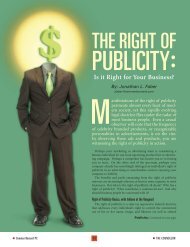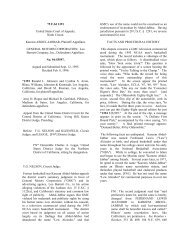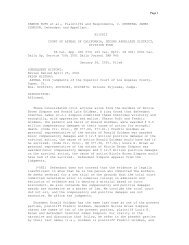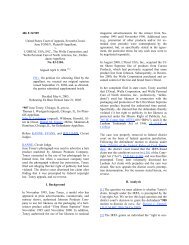Johnny Carson v. Here's Johnny Portable Toilets ... - Right Of Publicity
Johnny Carson v. Here's Johnny Portable Toilets ... - Right Of Publicity
Johnny Carson v. Here's Johnny Portable Toilets ... - Right Of Publicity
You also want an ePaper? Increase the reach of your titles
YUMPU automatically turns print PDFs into web optimized ePapers that Google loves.
Dean Prosser's analysis has been a source of someconfusion in the law. His first three types of theright of privacy generally protect the right "to be letalone," while the right of publicity protects thecelebrity's pecuniary interest in the commercialexploitation of his identity. Zacchini, supra, 433U.S. at 573, 97 S.Ct. at 2856. See generally The<strong>Right</strong> of <strong>Publicity</strong>-- Protection for Public Figures andCelebrities, 42 Brooklyn L.Rev. 527 (1976). Thus,the right of privacy and the right of publicity protectfundamentally different interests and must beanalyzed separately.[6] We do not believe that <strong>Carson</strong>'s claim that hisright of privacy has been invaded is supported by thelaw or the facts. Apparently, the gist of this claim isthat <strong>Carson</strong> is embarrassed by and considers it odiousto be associated with the appellee's product. Clearly,the association does not appeal to <strong>Carson</strong>'s sense ofhumor. But the facts here presented do not, itappears to us, amount to an invasion of any of theinterests protected by the right of privacy. In anyevent, our disposition of the claim of an invasion ofthe right of publicity makes it unnecessary for us toaccept or reject the claim of an invasion of the rightof privacy.*835 [7] The right of publicity has developed toprotect the commercial interest of celebrities in theiridentities. The theory of the right is that a celebrity'sidentity can be valuable in the promotion of products,and the celebrity has an interest that may be protectedfrom the unauthorized commercial exploitation ofthat identity. In Memphis Development Foundationv. Factors Etc., Inc., 616 F.2d 956 (6th Cir.), cert.denied, 449 U.S. 953, 101 S.Ct. 358, 66 L.Ed.2d 217(1980), we stated: "The famous have an exclusivelegal right during life to control and profit from thecommercial use of their name and personality." Id. at957.[8] The district court dismissed appellants' claimbased on the right of publicity because appellee doesnot use <strong>Carson</strong>'s name or likeness. 498 F.Supp. at 77.It held that it "would not be prudent to allow recoveryfor a right of publicity claim which does not morespecifically identify <strong>Johnny</strong> <strong>Carson</strong>." 498 F.Supp. at78. We believe that, on the contrary, the districtcourt's conception of the right of publicity is toonarrow. The right of publicity, as we have stated, isthat a celebrity has a protected pecuniary interest inthe commercial exploitation of his identity. If thecelebrity's identity is commercially exploited, therehas been an invasion of his right whether or not his"name or likeness" is used. <strong>Carson</strong>'s identity may beexploited even if his name, John W. <strong>Carson</strong>, or hispicture is not used.In Motschenbacher v. R.J. Reynolds Tobacco Co.,498 F.2d 821 (9th Cir.1974), the court held that theunauthorized use of a picture of a distinctive race carof a well known professional race car driver, whosename or likeness were not used, violated his right ofpublicity. In this connection, the court said:We turn now to the question of "identifiability."Clearly, if the district court correctly determined asa matter of law that plaintiff is not identifiable inthe commercial, then in no sense has plaintiff'sidentity been misappropriated nor his interestviolated.Having viewed a film of the commercial, we agreewith the district court that the "likeness" of plaintiffis itself unrecognizable; however, the court'sfurther conclusion of law to the effect that thedriver is not identifiable as plaintiff is erroneous inthat it wholly fails to attribute proper significanceto the distinctive decorations appearing on the car.As pointed out earlier, these markings were notonly peculiar to the plaintiff's cars but they causedsome persons to think the car in question wasplaintiff's and to infer that the person driving thecar was the plaintiff.Id. at 826-827 (footnote omitted).In Ali v. Playgirl, Inc., 447 F.Supp. 723(S.D.N.Y.1978), Muhammad Ali, formerheavyweight champion, sued Playgirl magazineunder the New York "right of privacy" statute andalso alleged a violation of his common law right ofpublicity. The magazine published a drawing of anude, black male sitting on a stool in a corner of aboxing ring with hands taped and arms outstretchedon the ropes. The district court concluded thatAli's right of publicity was invaded because thedrawing sufficiently identified him in spite of thefact that the drawing was captioned "MysteryMan." The district court found that theidentification of Ali was made certain because ofan accompanying verse that identified the figure as"The Greatest." The district court took judicialnotice of the fact that "Ali has regularly claimedthat appellation for himself." Id. at 727.In Hirsch v. S.C. Johnson & Son, Inc., 90 Wis.2d379, 280 N.W.2d 129 (1979), the court held thatuse by defendant of the name "Crazylegs" on ashaving gel for women violated plaintiff's right ofpublicity. Plaintiff, Elroy Hirsch, a famousfootball player, had been known by this nickname.The court said:







